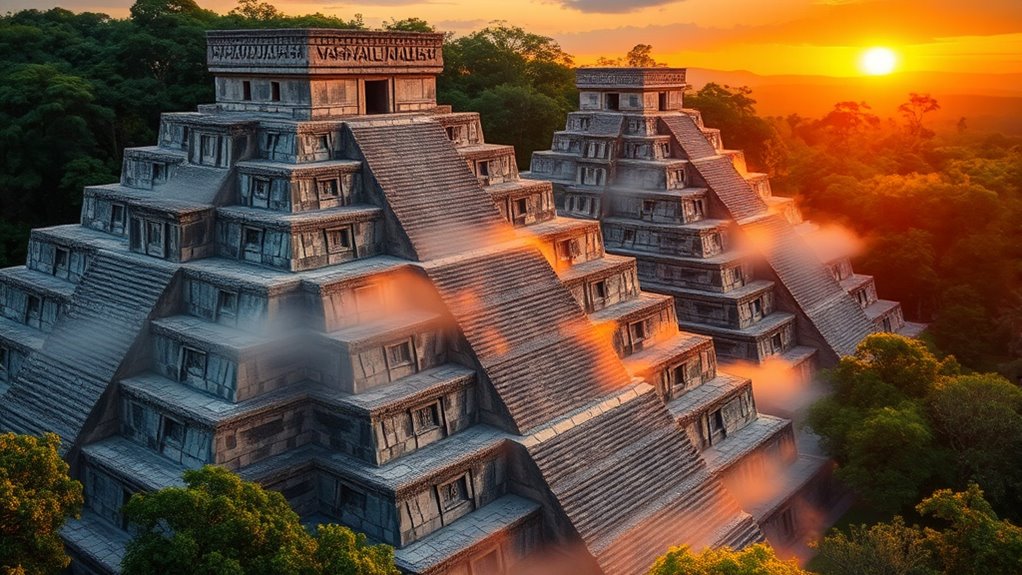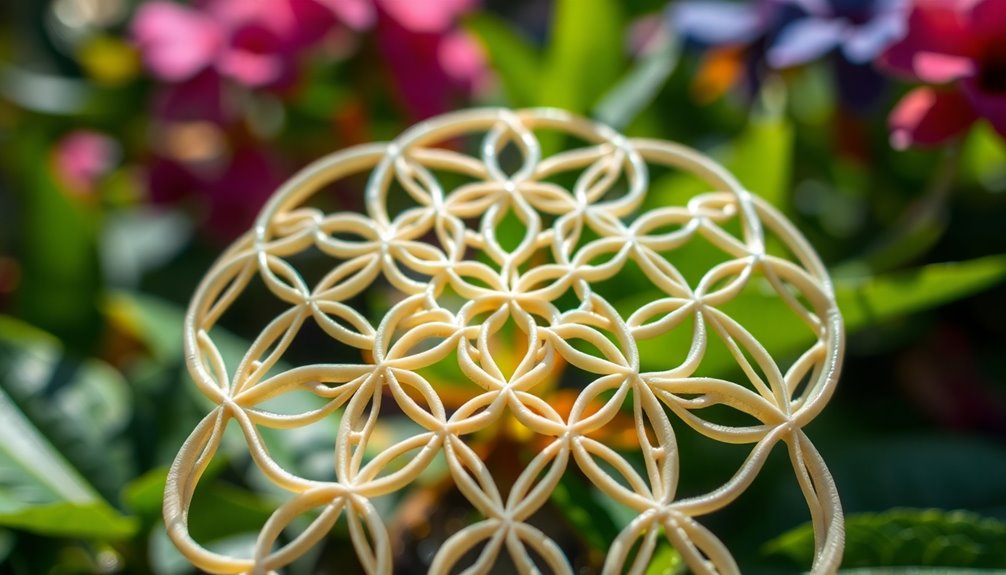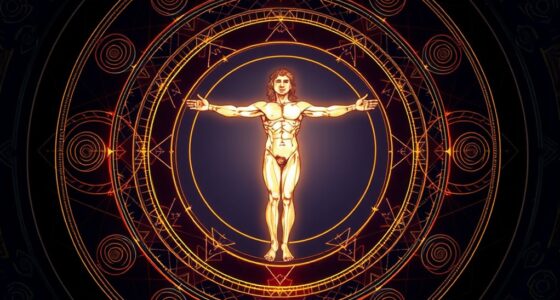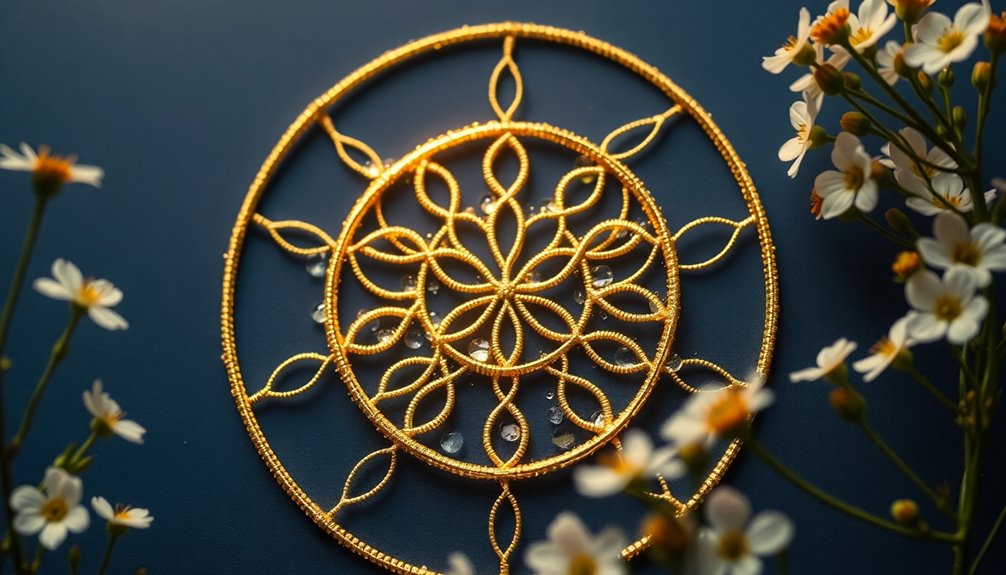In Mayan pyramids, sacred geometry plays a key role by guiding their precise alignment with celestial events like solstices and equinoxes, creating a cosmic connection. Symbols such as serpents and glyphs carved into the stones reinforce spiritual beliefs and divine forces. These structures embody Mayan cosmology, integrating art, science, and religion into harmonious designs. Exploring these sacred patterns reveals how Mayan culture expressed its cosmological worldview through architectural and symbolic mastery—something worth uncovering further.
Key Takeaways
- Mayan pyramids incorporate sacred symbols like serpents and glyphs, reflecting spiritual beliefs and cosmology.
- Architectural alignments with solstices and equinoxes demonstrate precise celestial geometry.
- The design employs sacred geometry to create harmony between structures and cosmic forces.
- Pyramids embody Mayan cosmology, representing the universe and serving as spiritual gateways.
- Integration of art, science, and religion showcases the use of sacred geometry in Mesoamerican culture.
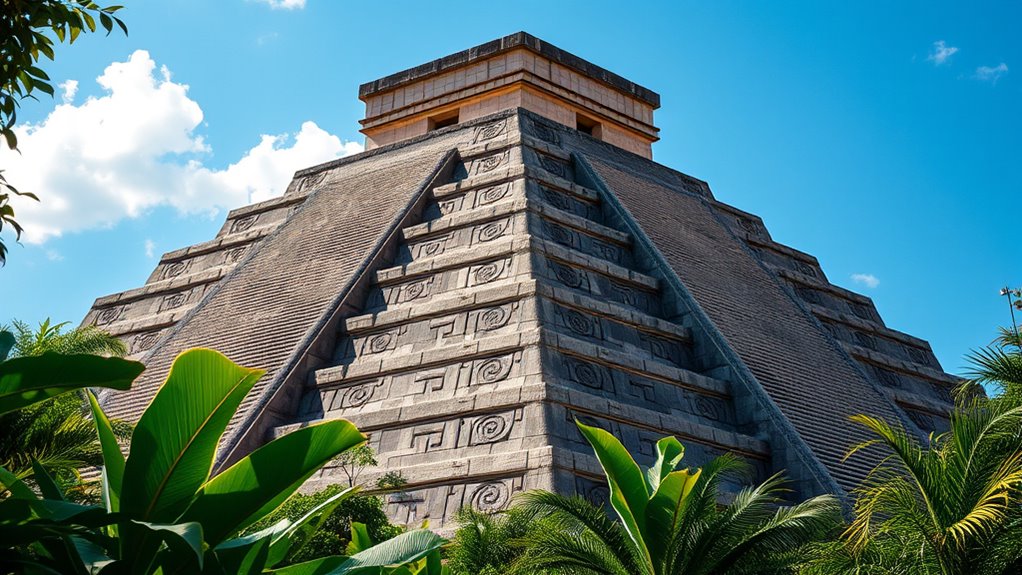
Have you ever wondered what secrets lie within the towering Mayan pyramids and the vibrant culture they represent? These ancient structures are more than just impressive feats of engineering; they embody a complex system of sacred symbols and precise architectural alignment that reveal the Mayans’ deep spiritual beliefs. When you study their pyramids, you’ll notice that every stone and every step seems intentionally placed, reflecting a sophisticated understanding of sacred geometry. The Mayans believed that certain shapes and alignments held spiritual power, connecting the earthly realm with the divine. This is why many pyramids are aligned with celestial events, such as solstices and equinoxes, creating a harmonious relationship between their architecture and the cosmos. These alignments weren’t accidental—they were deliberate, serving as astronomical calendars and spiritual gateways.
Sacred symbols play an essential role in understanding the significance of Mayan pyramids. You’ll see motifs like serpents, jaguars, and glyphs carved into their stones, each carrying a specific spiritual meaning. The serpent, for instance, often symbolizes rebirth and the connection between the earthly and spiritual worlds. These symbols are woven into the very design of the structures, emphasizing their sacred purpose. The pyramids and temples aren’t just physical spaces—they’re representations of the universe, reflecting Mayan cosmology and their view of time and space. Every carving and symbol was carefully chosen to reinforce religious beliefs, making the pyramid a sacred site for rituals, offerings, and ceremonies.
The architectural alignment of Mayan pyramids is a testament to their mastery of sacred geometry. You’ll notice that many of these structures are positioned precisely in relation to each other and to specific celestial events. For example, the layout of El Castillo at Chichen Itza perfectly aligns with the setting sun during the equinox, creating a shadow that resembles a serpent descending the staircase. This alignment isn’t arbitrary; it’s a deliberate design meant to evoke divine forces and reinforce the spiritual significance of the site. The Mayans used their understanding of sacred symbols and geometry not only for religious purposes but also to mark important astronomical and calendrical moments. Their architecture served as a physical manifestation of their spiritual worldview, blending science, art, and religion into a unified expression of sacred knowledge.
Frequently Asked Questions
How Did Mayans Develop Their Understanding of Sacred Geometry Without Modern Tools?
You see, the Mayans developed their understanding of sacred geometry through ancient measurement and intuitive design. They observed natural patterns and celestial movements, which guided their precise calculations. By carefully studying the environment and applying their keen intuition, they created harmonious structures without modern tools. This deep connection to nature and their environment allowed them to craft pyramids aligned with cosmic principles, showcasing their advanced knowledge of sacred geometry.
Are There Specific Astronomical Alignments Related to Sacred Geometry in These Structures?
You notice that many Mayan structures feature precise astronomical alignments, reflecting their deep understanding of celestial symmetry. These alignments often correspond to solstices, equinoxes, or planetary events, showing how sacred geometry integrates with astronomy. By observing the skies carefully, they aligned their pyramids and temples to specific celestial bodies, demonstrating their sophisticated knowledge of astronomical phenomena and their significance in Mesoamerican spirituality and architecture.
What Symbols or Patterns in Mayan Art Reflect Sacred Geometric Principles?
You see Mayan art symbolism woven with sacred geometric patterns, reflecting their spiritual worldview. The intricate motifs often feature spirals, grids, and polygons, embodying harmony, balance, and cosmic order. These symbols serve as visual representations of sacred principles, connecting the earthly to the divine. By studying these patterns, you uncover a language that expresses complex philosophical ideas through geometric beauty, revealing the profound relationship between art, spirituality, and sacred geometry.
How Does Sacred Geometry Influence the Spiritual Significance of Mayan Rituals?
You see that sacred geometry shapes Mayan rituals by fostering cosmic harmony and spiritual alignment. When you participate in these ceremonies, you’re connecting with the universe’s divine order, feeling the intricate patterns guide your spiritual journey. This geometric symbolism helps you align your inner self with higher cosmic forces, deepening your spiritual experience and reinforcing the sacred connection between the physical and spiritual worlds.
Can Sacred Geometric Principles Be Found in Other Mesoamerican Cultures Beyond the Mayans?
You’ll find sacred geometric principles in other Mesoamerican cultures, not just the Mayans. For example, the Aztecs incorporated complex Pre-Columbian astronomy and Mesoamerican symbolism into their architecture and rituals. Nearly 80% of their sacred sites align with celestial events, showing a deep understanding of geometric harmony. These patterns reveal a shared focus on cosmic order, emphasizing the spiritual significance of geometry across diverse Mesoamerican civilizations.
Conclusion
As you explore Mayan pyramids and Mesoamerican culture, you’ll see how sacred geometry shaped their architecture and spiritual practices. Did you know that the Pyramid of Kukulcán aligns perfectly with the solstice sun, creating an awe-inspiring spectacle? This precise alignment highlights their advanced understanding of astronomy and geometry. By studying these structures, you gain a deeper appreciation for their sophisticated knowledge and how it intertwined with their cultural and religious beliefs.

